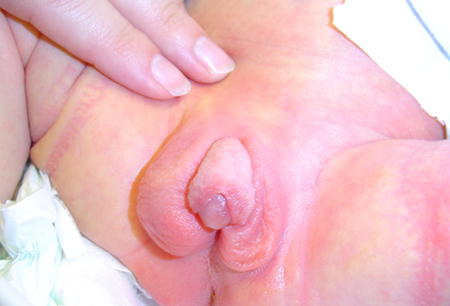Summary
Definition
History and exam
Key diagnostic factors
- genitales atípicos sin gónadas palpables
- genitales atípicos con una gónada palpable
- genitales atípicos con gónadas palpables bilateralmente
- longitud del pene <2.5 cm en un varón fenotípico
- clítoris >1 cm en un lactante de fenotipo femenino
- hipospadias y testículos que no han descendido, o separación de los sacos escrotales
- abertura uretral en la base del pene
Other diagnostic factors
- hipotensión y vómitos
- rasgos faciales dismórficos
Risk factors
- antecedentes familiares
Diagnostic tests
1st tests to order
- análisis cromosómicos (cariotipo)
- electrolitos séricos y glucosa
- ultrasonido pélvico
Tests to consider
- 17-hidroxiprogesterona sérica
- actividad de la renina plasmática
- 11-desoxicortisol y 11-desoxicorticosterona séricos
- testosterona en suero
- dihidrotestosterona sérica
- hormona luteinizante (LH) y hormona foliculoestimulante (FSH) séricas
- prueba de estimulación con hormona adrenocorticotrópica (ACTH).
- prueba de estimulación con gonadotropina coriónica humana (hCG)
- hormona antimülleriana (HAM)
- perfil de esteroides en orina
Treatment algorithm
todos los neonatos que presenten genitales atípicos
46,XX: hiperplasia suprarrenal congénita secundaria a una deficiencia de 21-hidroxilasa (en la presentación)
46,XY
disgenesia gonadal mixta 45,X/46,XY
46,XX: hiperplasia suprarrenal congénita secundaria a una deficiencia de 21-hidroxilasa (después de la asignación de sexo)
46,XY
disgenesia gonadal mixta 45,X/46,XY
Contributors
Authors
Justin H Davies, MD, FRCPCH, MRCP
Consultant Paediatric Endocrinologist
Hon. Associate Professor
University of Southampton
Southampton
UK
Disclosures
JD is associate editor for the Journal of Paediatric Endocrinology and Metabolism; has travel bursaries from SANDOZ, Kwyo Kyrin, and Novo Nordisk; and has developed educational materials for Kwyo Kyrin. JD completed tenure as chair of the British Society for Paediatric Endocrinology in Nov 2020.
Acknowledgements
Dr Justin Davies would like to gratefully acknowledge Dr Gemma Watts and Dr Ingrid A. Holm, previous contributors to this topic. IAH and GW declare that they have no competing interests.
Peer reviewers
Paul Saenger, MD, MACE
Professor of Pediatrics
Department of Pediatrics (Endocrinology)
Montefiore Medical Center
Albert Einstein College of Medicine
New York
NY
Disclosures
PS declares that he has no competing interests.
Mary M. Lee, MD
Professor of Pediatrics and Cell Biology
Vice-Chair of Academic Affairs in Pediatrics
Pediatric Endocrine Division
UMass Medical School
Worcester
MA
Disclosures
MML declares that she has no competing interests.
Patricia Y. Fechner, MD
Associate Professor Pediatrics
Pediatric Endocrinology
University of WA
Medical Director of DSD Program
Seattle Children’s Hospital
Seattle
WA
Disclosures
PYF declares that she has no competing interests.
Peer reviewer acknowledgements
BMJ Best Practice topics are updated on a rolling basis in line with developments in evidence and guidance. The peer reviewers listed here have reviewed the content at least once during the history of the topic.
Disclosures
Peer reviewer affiliations and disclosures pertain to the time of the review.
References
Key articles
Lee PA, Nordenström A, Houk CP, et al. Global disorders of sex development update since 2006: perceptions, approach and care. Horm Res Paediatr. 2016 Jan 28;85(3):158-80.Full text Abstract
Cools M, Nordenström A, Robeva R, et al. Caring for individuals with a difference of sex development (DSD): a Consensus Statement. Nat Rev Endocrinol. 2018 Jul;14(7):415-29.Full text Abstract
MacLaughlin DT, Donahoe PK. Sex determination and differentiation. N Engl J Med. 2004 Jan 22;350(4):367-78. Abstract
Lambert SM, Vilain EJ, Kolon TF. A practical approach to ambiguous genitalia in the newborn period. Urol Clin North Am. 2010 May;37(2):195-205. Abstract
Davies JH, Cheetham T. Recognition and assessment of atypical and ambiguous genitalia in the newborn. Arch Dis Child. 2017 Apr 25 [Epub ahead of print]. Abstract
Chavhan GB, Parra DA, Oudjhane K, et al. Imaging of ambiguous genitalia: classification and diagnostic approach. Radiographics. 2008 Nov-Dec;28(7):1891-904. Abstract
Brain CE, Creighton SM, Mushtaq I, et al. Holistic management of DSD. Best Pract Res Clin Endocrinol Metab. 2010 Apr;24(2):335-54.Full text Abstract
Mieszczak J, Houk CP, Lee PA. Assignment of the sex of rearing in the neonate with a disorder of sex development. Curr Opin Pediatr. 2009 Aug;21(4):541-7. Abstract
Reference articles
A full list of sources referenced in this topic is available to users with access to all of BMJ Best Practice.

Differentials
- Micropene debido a otra causa
- Testículo no descendido (criptorquidia) unilateral
More DifferentialsGuidelines
- Guidelines on paediatric urology
- UK guidance on the initial evaluation of a suspected difference or disorder of sex development (revised 2021)
More GuidelinesLog in or subscribe to access all of BMJ Best Practice
Use of this content is subject to our disclaimer